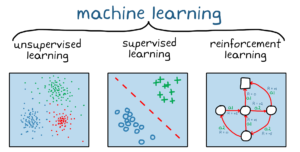
Reinforcement-learning
Mastering Reinforcement Learning:
Reinforcement learning (RL) is a rapidly evolving field of artificial intelligence that can potentially transform the world as we know it. It is the foundation of many cutting-edge technologies, including autonomous vehicles, robotics, gaming, and more. Despite its potential, mastering RL can be daunting, even for the most experienced professionals. That’s where this comprehensive guide comes in. This article will explore the fundamentals of RL, its applications, and how to master it. Whether you are a beginner or an experienced practitioner, this guide will help you understand RL’s key concepts and techniques. We will cover everything from the basics of RL to advanced techniques such as deep reinforcement learning, policy gradient methods, and more. This short article is designed to be accessible, engaging, and practical, so you can start mastering RL immediately. So, let’s dive in and explore the exciting world of reinforcement learning together!
History and Development of Reinforcement Learning:
Reinforcement learning has a rich history that dates back to the 1950s. The initial work on RL was done by researchers such as Arthur Samuel, who developed a checkers-playing program that learned by playing against itself. However, the field of RL gained more attention in the 1990s when researchers developed algorithms such as Q-learning and SARSA, which could solve more complex problems.
The development of deep learning in the 2010s further accelerated progress in RL, leading to breakthroughs such as AlphaGo, which defeated the world champion in the board game Go. Since then, researchers and practitioners have applied RL to various problems, including robotics, gaming, finance, and healthcare.
Key Concepts in Reinforcement Learning:
To understand RL, it is important to start with its key concepts. The four main components of RL are the agent, environment, reward signal, and action. The agent is the decision-maker that interacts with the environment by taking actions and receiving feedback through rewards or penalties. The environment is the external system in which the agent operates and provides feedback. The reward signal is a scalar value that indicates the success or failure of the agent’s actions. The action is the agent’s decision based on the environment’s current state.
Types of Reinforcement Learning:
There are two main types of RL: model-based and model-free. In model-based RL, the agent has access to a model of the environment that allows it to predict the outcome of its actions. In contrast, in model-free RL, the agent learns directly from experience without building a model of the environment.
Model-based RL has the advantage of planning ahead and making better decisions. However, it requires accurate knowledge of the environment, which may only sometimes be available. On the other hand, model-free RL is more flexible and can adapt to changes in the background. However, it may require more data to learn the optimal policy.
Reinforcement Learning Algorithms:
Several algorithms are used in RL, including Q-learning, SARSA, and Deep Q Networks (DQNs). Q-learning is a model-free algorithm that uses a table to store the expected reward for each state-action pair. SARSA is another model-free algorithm that learns the optimal policy by updating the expected reward based on the current state and the following action. DQNs are a type of deep learning algorithm that uses neural networks to approximate the action-value function.
Each algorithm has its strengths and weaknesses and may perform better in certain situations. For example, Q-learning suits problems with a few states and actions, while DQNs are better suited for problems with many states and actions.
Applications of Reinforcement Learning:
Various industries have utilized RL, including gaming, robotics, and finance. Gaming has employed RL to develop agents capable of playing complex games like chess, Go, and poker. Robotics has utilized RL to train robots in tasks such as object grasping, navigation in complex environments, and learning from human demonstrations. In finance, industry professionals have applied RL to optimize portfolios, manage risks, and engage in algorithmic trading.
Implementing Reinforcement Learning:
Implementing RL requires a good understanding of programming languages and tools. Python is a popular language for implementing RL algorithms due to its simplicity and availability of libraries such as TensorFlow and PyTorch. Other tools, such as OpenAI Gym, which provides a set of environments for RL experiments, and RLlib, which is a library for scalable RL, can also be helpful.
Reinforcement Learning in Action:
To illustrate the power of RL, let’s look at some examples of how it has been applied in the real world. One example is the development of AlphaGo, which used a combination of RL and deep learning to defeat the world champion in the board game Go. Another example is the development of autonomous vehicles, which use RL to learn how to navigate complex environments and avoid obstacles. RL has also been applied to natural language processing, where agents can learn to generate human-like responses to text-based inputs.
Challenges and Limitations of Reinforcement Learning:
While RL has shown great promise in many applications, it also faces several challenges and limitations. One challenge is the problem of the exploration-exploitation tradeoff, where the agent needs to balance between exploiting the current knowledge and exploring new actions. Another challenge is the issue of credit assignment, where the agent needs to attribute the reward to the steps that led to it. RL also needs to work on the problem of catastrophic forgetting, where the agent forgets previously learned knowledge when it learns new information.
Future of Reinforcement Learning:
Despite the challenges, RL has a bright future ahead. As researchers continue to develop new algorithms and techniques, RL will become even more powerful and applicable to a broader range of problems. RL can also be combined with other fields like deep learning, natural language processing, and computer vision to create even more advanced systems.
Conclusion:
Reinforcement learning is a rapidly evolving field that can potentially transform many industries. In this comprehensive guide, we explored the fundamental concepts of RL, its algorithms, applications, and limitations. We also looked at some real-world examples of RL in action and discussed the future of the field. Whether you are a beginner or an experienced practitioner, mastering RL can be a rewarding experience that opens up many opportunities. So, go ahead and dive into the exciting world of reinforcement learning!
